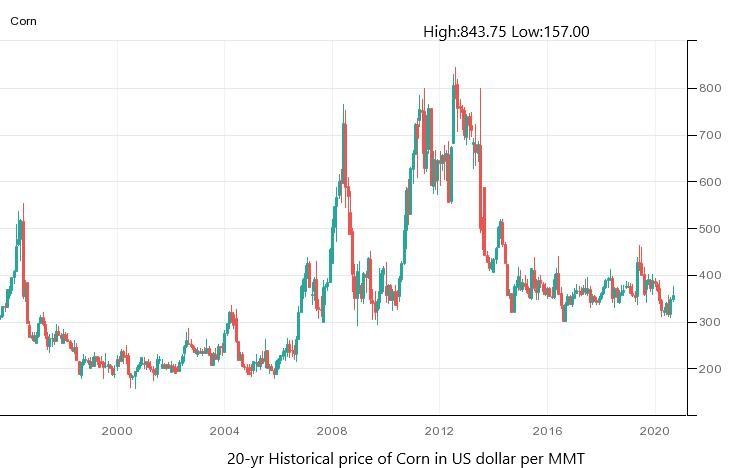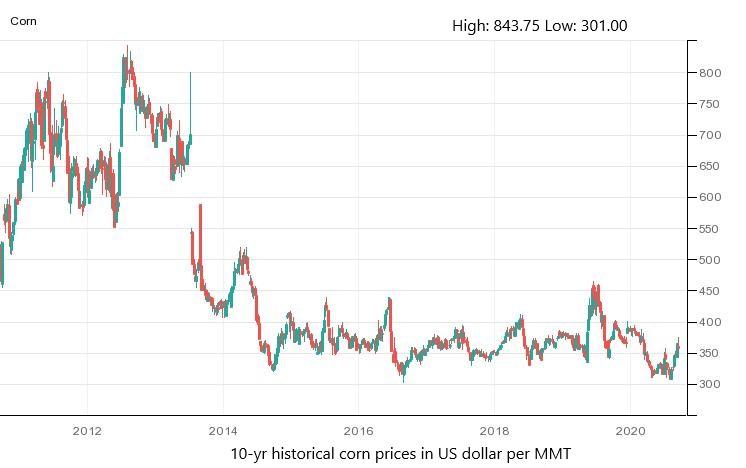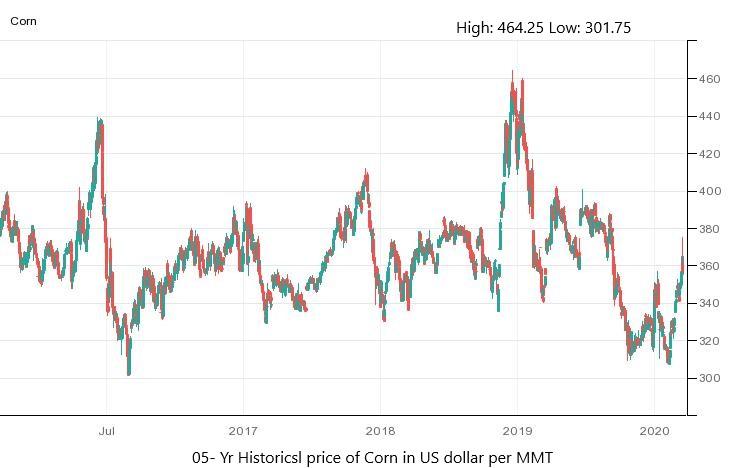Corn is the world’s most important grain, based on the production volume. In 2019-20, the worldwide corn production was recorded as 1,114.75 million metric tons, with the United States at the top with 406,292,000 metric tons and China in second place with 260,000,000 metric tons. Brazil ranked third, with 106,000,000 metric tons of corn produced in 2019. Corn is one of the most important crops in the United States as, over the last years, the country’s corn farmers have experienced a constant increase in annual revenues. As with the production, the largest consumer country for corn is also the United States, with a consumption of 12.3 billion bushels of corn in 2019. In the same year, China came second in terms of consumption, at 10.98 billion bushels. The primary usage of corn includes livestock feed, ethanol production and manufactured goods. Corn futures are one of the most widely traded commodities futures products in the world. Corn futures started trading in the Chicago commodities futures markets in the mid-1880s. This high consumption grain is also known as the “other yellow gold” because of its value around the globe throughout most of the history of mankind. Like all other investments, the corn futures price fluctuates according to weather, supply, demand and speculation. Other than that, the ethanol demand, the demand from China, the Planting Intentions Report, the USDA report and the US dollar prices also affect the corn prices.



Why Look at Historic Corn Prices?
There are manifold factors involved in the determination of a bearish bias in corn. Let’s explore them one by one, in order to forecast the corn prices.
Protection against Inflation:
In bad economic times, like the ongoing US-China trade war and the coronavirus pandemic crisis, that led to the global economic slowdown, the Central Banks from across the globe tend to print money to prevent the economy from falling into recession. However, this printing of money, or loose monetary policy, causes inflation, which in turn makes the money in bank accounts worthless. At such times, investing in a commodity like corn, can protect the value of money against inflation. This is because such commodities have a direct and positive correlation, which means that, with the increasing global inflation, the corn prices also increase and vice versa.
Ethanol Demand:
Other than its usage as a food, corn is also used to produce biofuels, such as ethanol. About 40% of the corn crop goes to ethanol production and most of what remains goes to feeding livestock. Only a small portion goes to human consumption. Therefore, it is important to monitor the prices of crude oil and gasoline, which determine the demand for ethanol. A cheap corn price while the price of crude oil is high can lead to an increased demand for ethanol. In the South, American ethanol is widely used for cars. The demand for biofuels has also been increasing in Europe recently, which has also raised the corn prices lately. The demand for biofuels is expected to increase in the coming years, as countries are seeking cleaner energy sources, and as a result, the corn prices will also increase, due to the increased demand for ethanol production.
Chinese Demand:
China’s demand for corn for animal feed has increased, as the number of pigs has rebounded more quickly than expected after the deadly swine disease, which was first detected in the country two years ago. Along with that, China’s pledge to buy more US farm products, as part of the Phase 1 trade deal with Washington, has also raised the demand for corn in China.
China is still far away from meeting its commitment of buying $ 36.5 billion worth of US agricultural goods, according to the Phase 1 agreement. The United States had exported about $ 7.274 billion in farm goods to China by the end of June. From January to June, the US exported 404,760 tonnes of Corn to China, which was a considerable increase, compared to 194,503 tonnes in the previous year.
Furthermore, the country has targets in place to increase biofuel consumption in the coming years, which could also increase the demand for corn. Meanwhile, with over a billion people whom China needs to feed, the country’s demand for corn will never decrease.
Planting Intentions Report:
In spring, the USDA’s Planting Intentions Report issues planting season figures for traders on financial markets. This report is released at the end of March. The said report tends to set the tone for the market for the season. The report discloses the amount of acreage that farmers anticipate planting for each crop. The fewer the acres planted, the lower the chance of a large crop. Analysts take the number of acres and multiply it by a trend yield, in order to get the expected size of the crop for the season, so that they can forecast the overall size of the crop. This report is viewed by the corn traders, and it also affects the prices of the commodity.
The USDA Report:
A detailed report about the demand for corn exports is released by the USDA every Thursday. Corn prices often move higher on the strong export report. The export prices of corn from other exporting countries should also be monitored. If the price of US corn is much higher than other competing countries, the chances for a strong export market will diminish.
Coronavirus Pandemic:
The price of corn futures fell by 15%, or 61 cents per bushel, to $ 3.35 per bushel in May, after the coronavirus pandemic forced nations worldwide to lockdown their economic and social activities. The decline was tied to the demand uncertainty that has followed the drop in ethanol future prices of nearly 40%. The prospects of 97 million acres of corn planted in 2020 also weighed heavily on corn prices. Corn has experienced a stronger reaction to COVID-19 measures, because of its usage in ethanol production, as the industries were shut down during the lockdown. Another major use of corn, namely for livestock feed, was also down, due to meat processing sectors being closed down, in order to protect workers from being infected by the COVID-19 virus.